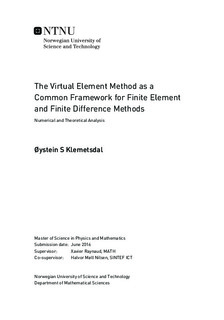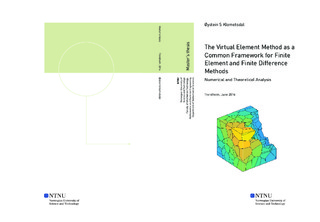| dc.description.abstract | Consistent discretizations of differential equations on polygonal and polyhedral grids is an active area of research. This is of particular interest in applications where the grid is constructed to capture the physical properties of the domain on which the differential equation is defined, for example in subsurface modelling. Recent developments in this area includes the mimetic finite difference method, which mimics the physical and mathematical properties of the problem. Construction of such methods involves choosing a term to ensure stability. Mimetic finite differences has later evolved into a finite element-like approach called the virtual element method, which is the topic of this thesis.
The work presented here consists of three parts: (i) A literature study of the virtual element method for Poisson problems, (ii) an analysis of the construction of the stability term of the virtual element method, and (iii) a MATLAB implementation of the virtual element method in two and three dimensions, for first and second order, accompanied by numerical examples.
A detailed proof of the well-posedness of the operator involved in constructing the virtual element function space is presented. We also present a detailed proof of that this projection can be calculated exactly for any function in the virtual element function space. Moreover, we show how the stability term can be chosen such that the bilinear form of the virtual element method equals the bilinear form it approximates. This is used to show that the stability term can be chosen such that local stiffness matrix of the first order virtual element is equal to the local stiffness matrix of the first order finite element method for certain cell geometries. It is also used to show that we can choose the stability term to obtain the same system of linear equations as for finite difference stencils. The MATLAB implementation is used to solve simple problems in two and three dimensions. We also use the implementation to investigate how the stability term can be used to minimize the error of the approximation in different norms. Finally, the implementation is compared to some of the most common methods used in reservoir simulations: Two-point and multipoint flux approximation, and mimetic finite differences. The implementation is robust to irregular cell geometries and high aspect ratios, and converges as predicted by the theory. Moreover, for pressure problems, it produces solutions which are close to or better than the solutions produced by the mentioned reservoir simulation methods. | |

